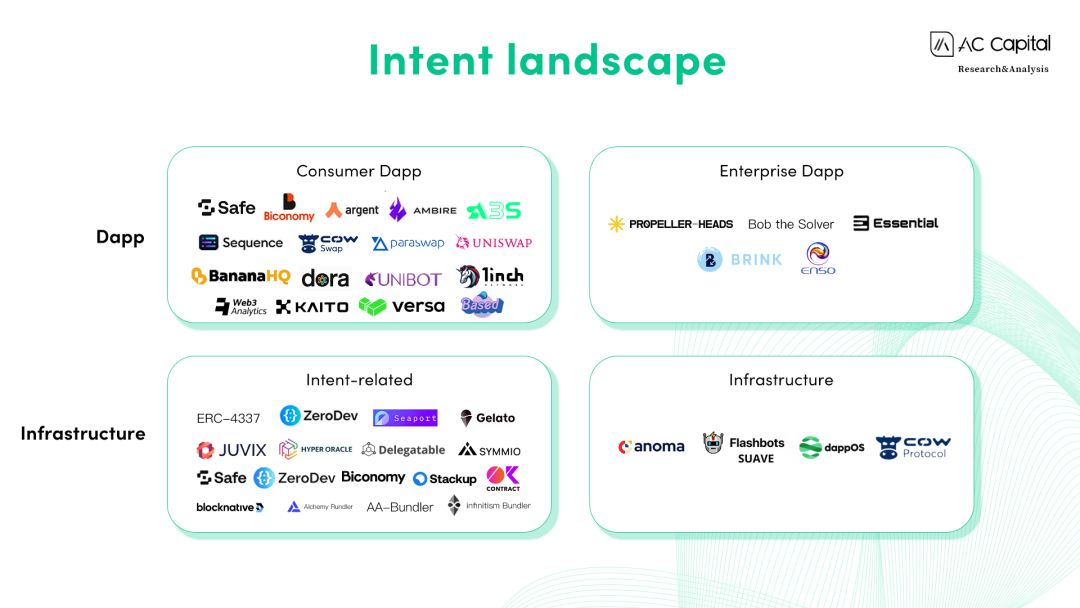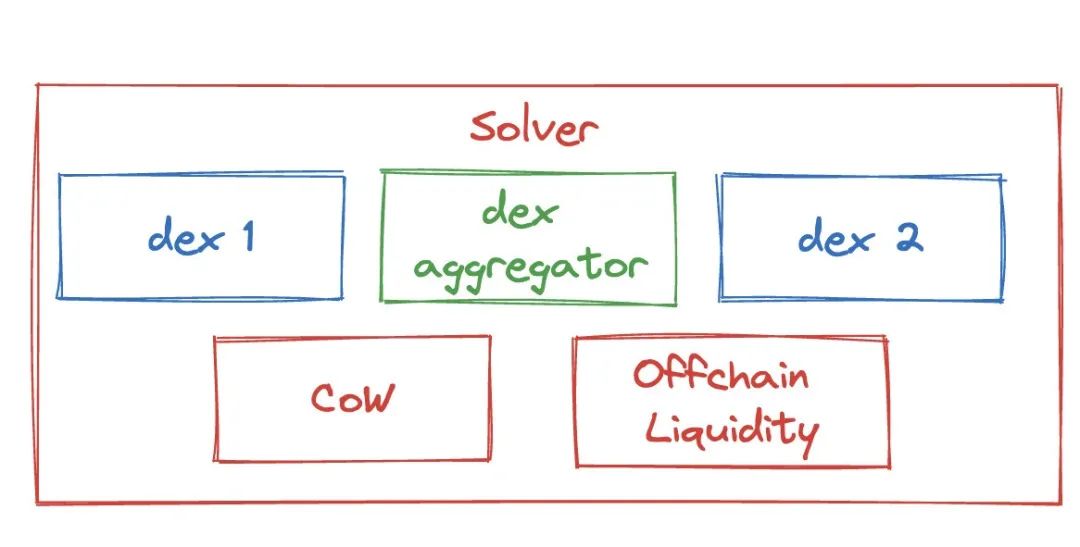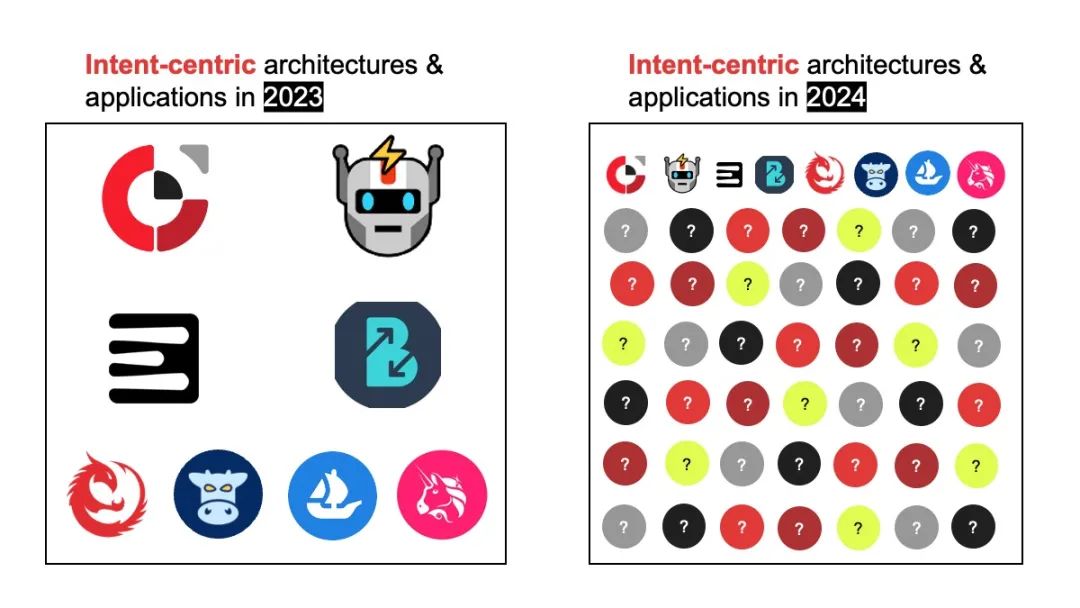Summary (TL;DR)
(1) Understanding Intent: Anoma from top-down and TG Bot from bottom-up
(2) In-depth Intent: AI is the New UI: Complex Commands vs. Simple Intent
(3) Navigating Intent: Evolution of the concept of Intent, interaction paradigms, current situation, trends
(4) Guiding Intent: Challenges and prospects of intelligent interaction in Web3
In June, Paradigm's official website published an article titled "Intent-Based Architectures and Their Risks," which brought the concept of Intent to the public for the first time. The development of protocols and infrastructure related to Intent has been rapid, and it became a topic that cannot be ignored in the crypto world at the ETHCC conference in July.
Intent is not a new concept, as stated by DForce founder Mindao: the trend in the cryptocurrency industry has always been to automate operations to the extreme. Aggregators, CEX, contract wallets, and cross-chain DeFi are all working on these tasks, as well as Chainlink and recent automated middleware, and the recent Telegram bot.
However, Intent brings about new changes. In the past, the focus was on product interaction, but in the AGI era, the focus is on human-machine interaction. AI/LLM (large language models) holds more potential for enhancing Crypto interaction.
01. Top-down Anoma and Bottom-up Unibot
In the past six months, protocols, projects, and infrastructure related to Intent have been booming. Instead of explaining the concepts, two excellent examples are presented.
One of the most prominent projects related to Intent is the Anoma Foundation, which completed its third round of financing of $25 million at the end of May 2023. In the context of severe homogenization in Layer1, the Anoma Foundation, with its intent-centric architecture Anoma (Dapp full-stack architecture) and Namada (privacy Layer1), received a total of $57.8 million in investment from institutions, ranking 7th in the amount of financing for unreleased Layer1/Layer2.
On the other hand, TG Bot has opened up the imagination of landing scenarios for Intent segmentation with on-chain automated trading tools. Unibot, a Telegram-based trading bot, allows users to automate DEX trading through Telegram and provides functions such as sniper purchases, copy trading, DEX limit orders, privacy, and anti-MEV. Unibot is based on Intent to replace the cumbersome interaction of Uniswap, providing a convenient DeFi interaction experience.
Both Anoma and TG Bot have the same goal—simplifying user interaction and introducing new programmable, customizable user interaction interfaces—User Intent Layer, allowing users to skip complex on-chain interactions and define transaction states based on user intent.
02. AI is the New UI: Command Interaction vs. Intent Interaction
The AI paradigm is introducing a new interaction mechanism, where users tell the computer what they want, rather than how to do it. This shift is bringing about a fundamental change in the user interaction interface for the crypto world.
Historically, each revolution in interaction modes has generated new business models. LLM-based generative AI has brought disruptive changes to human-machine interaction, transforming the interaction with various software UIs into interaction with Chatgpt chat windows. LLM+crypto brings a new proposition of intent-based interaction to the crypto world, potentially making blockchain interactions more intelligent.
03. Evolution of the Concept of Intent, Interaction Paradigms, Current Situation, Trends
After gaining a deep understanding of the AI intelligence trend behind Intent, further exploration is made into the evolution of the concept of Intent. Intent is not a new concept, having existed since the Web2 era. With the rise of search engines like Google, users could input their intent, and the search engine would provide relevant search results to fulfill that intent.
With the rise of e-commerce platforms like Amazon and eBay, there was a significant shift in intent-based architecture. Users could now express their intent to purchase products, and the platform would handle the logistics. In early 2017, Gartner released a report "Innovation Insight: Intent-Based Networking Systems," formally introducing the concept of Intent-based Networking. The key to intent-based networking is presenting users with an interface where they only need to express what they want, and the platform handles the business details.
Intent-based networking represents the automatic and intelligent development trend of networks in the Web2 era. Gartner's research vice president Andrew Lerner pointed out in 2017 that intent-based networking would be the next milestone in the network field.
Source: https://www.gartner.com/en/documents/3599617
Evolution from Web2 to Web3, the concept of intent in Web3 is not yet clear, but there are some consensuses:
- Definition given by Paradigm: Intent is a set of declarative constraints that allow users to delegate transaction creation to specialized third-party participant networks while retaining complete control over the process.
- Definition given by Anoma, the underlying Dapp architecture based on intent: Intent is a message sent by the user to express custom preferences. Intent is the user's definition of what the system can do, rather than the specific execution path.
- Definition given by Propellerheads, the intent-based transaction infrastructure: Intent is the part of a transaction that requires assistance from others. Intent simplifies complex transactions by outsourcing difficult parts to third parties.
In real-world use cases of Web3-based intent-based transactions, users create intent off-chain and outsource it to a solver off-chain, encapsulating the complexity of blockchain interaction to the solver while retaining complete control over the process on-chain, thus lowering the barrier for on-chain interaction.

Source: https://www.brink.trade/blog/powerful-intents-part-1
Intent also brings the concept of LLM architecture—intent-centric—architecture centered around user intent. Currently, intent-centric related crypto protocols and infrastructure are embedded in the interaction layer between users and Crypto, providing a better on-chain interaction experience with the help of LLM.
LLM+Crypto brings a new human-machine interaction paradigm, directly converting user intent into smart contract calls. Users only need to express their intent, similar to using Apple's Siri, and the bot/AI agent/third-party solver helps complete complex on-chain operations. In the future, intent-based Web3 interaction intelligence has the potential to significantly reduce the complexity of user on-chain interactions.

AI is the New UI, and more and more Web3 projects are exploring the power of intent. Whether it's intent-based Dapps or intent-based underlying architectures, they unleash the potential of intent from different perspectives. We attempt to categorize this rapidly developing field from an interaction perspective into four major categories and track the latest status and trends:

Infrastructure: (Intent-centric intent architecture layer)
- DappOS: The first intent-centric Web3 operating protocol, building an intermediate layer between users and encrypted infrastructure such as public chains and cross-chain bridges, allowing Web3 users to seamlessly interact with products. DappOS recently released V2.
- Flash 2.0 SUAVE: SUAVE is an independent plug-and-play modular MEV full-chain sorting layer. Preferences (the core concept of SUAVE) are similar to the concept of Intent, providing a way for ordinary users to customize transactions and ultimately help users achieve optimal execution. Flashbots plans to launch SUAVE Centauri in 2023Q4.
- Anoma: A universal Dapp architecture centered around intent, deployable in a modular fashion to L1, L1.5, L2, and embeddable in various EVM frameworks using modular components. The latest development in the Anoma ecosystem is the upcoming v0.22.0 testnet release of Namada, the privacy settlement Layer1 for Anoma.
- Cow Protocol: CoW Protocol builds a foundational settlement network for traders and solvers and released the new intent system, Cow Hooks, in July to enable custom DeFi operations. In August, CoW Protocol processed a total transaction volume of 1.05 billion and generated a profit of 5.3 million.
Supporting Facilities: (Supporting infrastructure related to intent and account abstraction wallets)
- ERC 4337: ERC 4337's User Operation layer is based on user intent, including token payment for gas, payment selection, and login methods, replacing the current transaction mempool to achieve account abstraction and improve wallet interaction experience.
- Supporting facilities related to account abstraction: Bundler infrastructure (StackUp, Blocknative, Alchemy Rundler, AA-Bundler, infinitism Bundler), Wallet SDKs (Safe, ZeroDev, Biconomy).
- Supporting facilities related to intent: Juvix (intent-based programming language), Seaport (open-source NFT trading protocol), Gelato (Web3 automated execution layer providing smart contract automation services), okcontract (low-level intent automation tool), Delegatable (smart contract authorization proxy tool), Hyper Oracle (off-chain automation service), symmio (intent-based on-chain derivatives trading framework).
Enterprise Applications: (Integrated Dapp intent infrastructure, API, modular intent layer, domain-specific solvers)
- Transaction Solver API: PropelleHeads.
- Intent API: EnsoFinance.
- Intent transaction infrastructure: Bob the Solver, Brink.
- Composable intent tools: Essential.
Consumer Applications: (Intelligent user interfaces for interaction such as Wallets, Dex, Web3 Ai Agents, intelligent search engines)
- Wallets: Safe, Bitconomy, Argent, Ambire, Sequence, Versa, A3SProtocol.
- Dex: CowSwap, Paraswap, Uniswap, 1inch, BananaHq, basedmarkets.
- Intelligent front-end: Unibot, Dora, Web3 Analytics, kaito.ai.
Based on intent-based architecture, supporting facilities, and enterprise-side applications (due to space constraints, only listed without elaboration), an attempt is made to address the underlying challenges of intent implementation. However, infrastructure cannot be built in a day. The trend in the consumer application layer of intent is what truly excites, showing the potential for intelligent interaction in wallets, Dex, and other interaction gateways.
Intelligent Wallets: ERC-4337 introduces a new UserOps layer, where users express intent, and then the bundler converts these intents into executable signed transactions. In recent months, the number of ERC4337 users has increased significantly, and ZeroDev, Biconomy, and Safe modular intelligent accounts are the most motivated to promote AA + intent. AA + intent has the potential to give rise to the arrival of intelligent wallet (SCW).

Source: https://dune.com/niftytable/account-abstraction
Dex Architecture Transformation: Intent-based trading aims to improve capital efficiency and user interaction experience. CoW Hooks has linked complex actions such as trading, bridging, staking, and deposits. UniswapX allows users to sign intent off-chain matching and on-chain settlement, and more intent-based DEXs like BananaHq, Brink, basedmarkets are gradually increasing. New Intent-based RFQ narratives (SYMMIO) are unfolding, and with more DEXs and aggregators transitioning to intent-based architectures, the landscape of DEX is undergoing significant changes.

Source: https://twitter.com/BananaHQio/status/1694013407929020740
Intelligent Interaction Gateways: Similar to the transformation of Web3 front-end interaction interfaces by TG Bot, interaction gateways focus on understanding user intent and systematically converting it into automated, actionable tasks. Not only trading bots like TG Bot, but also Web3 Ai Agents and Web3 intelligent search engines are making Web3 interactions more intelligent.

Source: https://twitter.com/awasunyin/status/169540582237605496
04. Challenges and Prospects of Intelligent Web3 Interaction
In the past, the user interaction experience of Web3 products has indeed hindered widespread adoption. The wealth creation effect on-chain has masked many product issues. At the ETHCC conference in July, developers extensively discussed the future of intent-centric, how it can help users achieve more intelligent DAPP interactions in Web3. However, the application of intent-centric still faces many challenges.
- Lack of intent-related programming languages (similar to Juvix)
- Lack of suitable intent architecture (similar to Anoma)
- Lack of domain-specific solvers (similar to Bob The Solver)
- Centralized and closed intent implementation (similar to CowSwap)
- Lack of front-end intent recognition solvers (similar to Unibot)
- Lack of composable intent implementation (similar to Brink)
- Intent security risks (mentioned in the Paradigm article)
There are challenges and hopes. With the emergence of intent-centric protocols, the future of Web3 has the potential to evolve into more user-friendly intelligent interaction interfaces. Users can interact with mainstream applications such as Uniswap, Blur, AAVE, etc., all in one place, making interaction as simple as hailing a ride with Uber. This is the real opportunity for Web3 Dapps to surpass Web2 in terms of user experience.
More importantly, with the combination of Anoma, Flashbots SUAVE, and DappOS, the vision for the future of intent-centric, on-chain interactions in Web3 will become more intelligent, customizable, and fair. By centering around intent, the power of decision-making will be back in the hands of users. Ordinary users can also empower third-party bots/solvers to complete customized transactions (fees, slippage, privacy, cross-chain, MEV, or other intents). In the future, users will no longer be passive participants on-chain or the exploited by MEV searchers and validators, but the true masters of on-chain activities.
Looking forward to the future of intelligent Web3 interaction, whether it's account abstraction, chain abstraction, or intent, Web3 is finally focusing on user experience, and the dawn of intelligent interaction is about to illuminate the dark forest.
Acknowledgments
Many thanks to Web3 Analytics, Crypto V, Haotian, Jason Chen, Luke, Grace Deng, SixSix.eth, POOR DAO, #017, armonio.eth, Kiwibig.eth for their valuable discussions, feedback, and opinions on this article.
References
[Links to various articles and resources]
免责声明:本文章仅代表作者个人观点,不代表本平台的立场和观点。本文章仅供信息分享,不构成对任何人的任何投资建议。用户与作者之间的任何争议,与本平台无关。如网页中刊载的文章或图片涉及侵权,请提供相关的权利证明和身份证明发送邮件到support@aicoin.com,本平台相关工作人员将会进行核查。




